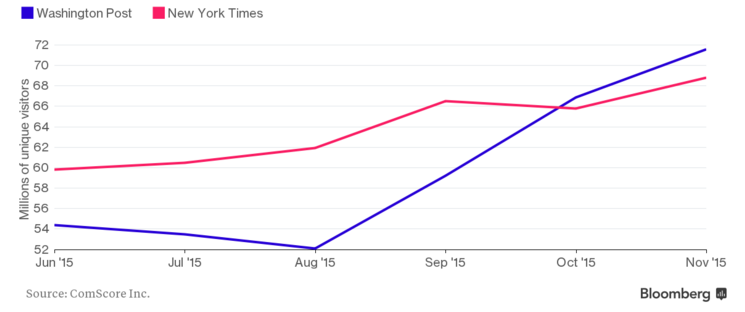Washington Post Finds Revenue Stream Through its Own CMS
Amazon CEO Jeff Bezos, who bought The Washington Post with $250 million of his personal fortune in August 2013, has led the once-proud newspaper into the digital future through developing the digital content management system, called Arc Publishing. Today, his efforts appear to be paying off, as the Post has recently announced the 11th outside news operation beside eight university papers in the U.S. who pay for its in-house CMS suite.
 "I am a huge fan of leaning into the future. I didn’t know anything about the newspaper business,” said Bezos, the creator of the online giant, Amazon, who purchased the struggling newspaper last year at a media conference. “But I did know something about the Internet. That, combined with the financial runway that I can provide, is the reason why I bought the Post.”
"I am a huge fan of leaning into the future. I didn’t know anything about the newspaper business,” said Bezos, the creator of the online giant, Amazon, who purchased the struggling newspaper last year at a media conference. “But I did know something about the Internet. That, combined with the financial runway that I can provide, is the reason why I bought the Post.”
When the Amazon founder acquired the newspaper from its publishers, the Graham family, no one was quite sure whether the Post would be a hobby for a man who didn’t know what to do with all his money or a newspaper turning into a laboratory for the digital future.
Under his leadership, Bezos wants the Post to become a Silicon Valley laboratory for the newspaper world. He has injected the idea of thinking big into the paper's editors and journalists and made them think about how to keep millions of readers interested for more than a decade or two. Instead of simply writing a cheque and keeping the status quo going on, he drove a cultural change, determined to turn the old world of newspaper publishers upside-down.
Hint of Amazon in the Air
Expectedly, there has been a hint of Amazon in the air at the Post, as any experimental idea which has a potential to acquire millions of new readers is supported and funded. In addition, the engineers at the Post held a project with their Amazon counterparts in order to develop a system on how to recommend stories better based on Amazon’s approach to recommending products to consumers.
Ken Doctor, Media Consultant and Analyst at Newsonomics, stated Bezos is utilizing some of the techniques he learned from building Amazon as the largest online retailer:
"Amazon is world class in the customer experience," Doctor told AFP. "It has figured out what people want and made that as seamless as possible. And it is Jeff Bezos's quest to bring that same level of understanding to The Washington Post." He added: "That's the roadmap—to learn rapidly about news readers in the same way that Amazon has learned about buyers of goods."
Washington Post executive editor Martin Baron interviewed Amazon.com chief executive and Washington Post owner Jeff Bezos May 18 at Transformers, a live event by The Washington Post about pushing the boundaries of knowledge:
Bezos’ Digital Revolution Pays Off
"It’s ridiculous to believe that Jeff Bezos came here with a magic pill to solve all the media industry's problems within a year -- that's a preposterous notion. If he knew already what worked, we would not need any experiments," says Martin Baron.
However, his digital revolution and behind-the-scene influence at the Washington Post have already started to yield very favorable results in and beyond the newsroom. The executives say the newspaper’s digital growth is from about 26 million unique visitors in August 2013 to about 76 million in December 2015. Potential numbers on the order of 100 million or more are being mentioned in the newsroom. It also has broadened its audience coverage as both national and international, thanks to the in-house CMS platform and lifted the headcount to about 70 in the newsroom, including about 50 reporters and editors, after years of almost weekly farewell parties in the paper.
The line chart below illustrates the newspaper eventually has surpassed the New York Times in unique U.S. Web visitors after two years of hard work:

Growing the Post’s audience was Bezos’ initial goal for the paper, but passing the New York Times in traffic was “just something that happened along the way,” says Jeff Burkett, Sr. Director, product strategy and operations at the Washington Post speaking at the 4A’s Transformation Conference in Miami.
As Burkett mentioned at the event, there are two important back-end technologies developed in-house by the Post engineers: Bandito, launched in February 2016 as a content testing technology that tests article headlines on The Washington Post’s website, and Prism, the Post’s own ad server launched in 2013.
Bloomberg's Gerry Smith reports on assessing “the Bezos effect” and says: "More than two years after he bought the Post from the Graham family for $250 million, Amazon CEO Jeff Bezos has shaped its digital transformation in ways big and small."
Last September, the newspaper enabled Amazon Prime subscribers to get free online access to the national edition for six months, with an option to continue subscribing at 60 percent off. Prior to this in 2014, the Post launched an app that comes preinstalled on Amazon Kindle Fire tablets. The organization announced that Kindle customers would receive six months of the digital version of the Post for free, and another six months would cost them only $1. The Post is also offering its content for free through websites of smaller newspapers around the United States, in a step toward fulfilling its ambition as a national rival to The New York Times and Wall Street Journal. It is certainly not a free strategy, yet Bezos reasons that once the Post has penetrated into the lives of millions of Americans, profits will somehow materialize on their own.
"We want to widen the funnel and give as many people access to the Washington Post as possible so that more and more people come down that funnel of engagement," says general manager Steve Hills.
"To make it work, you first have to have the commitment to truly changing the business," says Alan Mutter, a former Chicago newspaper editor who now consults on digital media. "You have to have confidence and the competence, and then the cash." Mutter also commented on the growth strategy: “It’s a work in progress but all of the signs I've seen suggest they know what they are doing in how to take an old and respected print brand and adapt it to the new world," he said.
How Did the Arc Publishing Platform Mature?
The Jeff Bezos-owned Washington Post was deeply unsatisfied with the CMS tools available at the time and wanted to transform itself into a digital era with a technology company mindset. As a result, they decided to build a technology solution in-house rather than buying one. The platform they built not only performs well, but provides analytics on how readers are interacting with the website and apps, and also collaborates with marketing to convey the desired messages to the target audience.
When The Washington Post first started looking at replacing its legacy content management systems, nobody planned to sell the technology they built to other media companies. However, executives at the Post started to think if there was a market to sell this sophisticated content management system after the in-house engineers developed every single piece of the suite. To find out, the organization asked some of the 250 newspapers participating in the Post’s digital partner program. As a result, many people in legacy media companies acknowledged the struggle. In response, the Post dedicated an engineering team to develop and harden the software to sell out of the newspaper.
 In Arc's early stages, The Post was very careful about the business prospects for a suite of web apps that take care of the functions of modern publishing. Amazingly, shortly after larger media companies began to show their interests in Arc, the Post had deliberately started with smaller organizations to understand how well the technology could handle before going to the next level with the larger companies. The newspaper began slowly with external tests of tools of the system at student newspapers at four universities. In 2015, the Post materialized its first sale to a small-size weekly newspaper, the Willamette Week, in Oregon, U.S.
In Arc's early stages, The Post was very careful about the business prospects for a suite of web apps that take care of the functions of modern publishing. Amazingly, shortly after larger media companies began to show their interests in Arc, the Post had deliberately started with smaller organizations to understand how well the technology could handle before going to the next level with the larger companies. The newspaper began slowly with external tests of tools of the system at student newspapers at four universities. In 2015, the Post materialized its first sale to a small-size weekly newspaper, the Willamette Week, in Oregon, U.S.
Shailesh Prakash, Chief Information Officer at The Washington Post, has moved 19 IT specialists and developers from their individual offices into the newsroom in order to enable them to collaborate with journalists and editors while developing new ideas.
The newspaper has held blind tests to understand readers’ preferences and by giving the focus group articles to read from competition such as New York Times, BuzzFeed, and the Huffington Post.
Arc Publishing is designed to respond to the needs of large, enterprise-level publishing companies such as news sites, online community sites, and media companies that publish hundreds of articles a day. The platform includes applications for scheduling and organization, story creation, print and online page-layout, syndication, comments, and analytics. Its major advantage is that users are enabled to make their content more interactive and engaging through enticing so many interactive elements such as A/B tested headlines, images, polls, quizzes, and so on.
Another interesting feature is the metered content paywall which allows users to access a limited number of free articles every month and then converts them to paying subscribers by enabling publishers to choose which content is free and which is be paid.
The Globe and Mail is on Board
Recently, The Globe and Mail has announced that they would become the largest North American media outlet to adopt The Washington Post’s Arc Publishing technology, with efforts to transition The Globe to the new platform starting immediately. In addition to adopting the new platform, The Globe will also continue to collaborate with The Post’s Arc team to co-develop new modules and integrations aimed at further expanding the system’s capabilities.
 “This partnership reflects the future of publishing – one that harnesses technology and analytics to enable audience-focused storytelling based on data science,” said Phillip Crawley, Publisher and CEO of The Globe and Mail. “In The Washington Post, we’ve found a partner that not only shares our vision but has emerged as a world leader in supporting modern publishers through digital innovation.”
“This partnership reflects the future of publishing – one that harnesses technology and analytics to enable audience-focused storytelling based on data science,” said Phillip Crawley, Publisher and CEO of The Globe and Mail. “In The Washington Post, we’ve found a partner that not only shares our vision but has emerged as a world leader in supporting modern publishers through digital innovation.”
“The Washington Post is now a media and technology company and Arc is our digital platform upon which we build innovative experiences for both readers and advertisers,” said Shailesh Prakash. “We are delighted that Canada’s national newspaper has chosen Arc as the technology platform to power their digital future and use its state-of-the-art capabilities to accelerate their plans for video, mobile, big data and distributed platforms. We respect The Globe and Mail’s commitment to innovation; they will be in good company in our Arc family.”
Before Jeff Bezos
Since August 201, a new calender has begun for the 137-year-old newspaper. To fully understand what this digital revolution means for The Post and the industry, it is almost imperative to roughly know the background of the digital transformation in the newspaper before Bezos.
 The Post, the largest newspaper in the US capital, launched its first website on June 19, 1996. Steve Coll, the Head of the Newsroom at the time, believed that the Internet would be the opportunity that could enable the Post to branch out beyond Washington. On May 20, 2004, Coll, supported by 40 department heads and managers at the Post, pitched his idea of going with an aggressive Internet strategy. The publisher Don Graham, 58 at the time, declined the idea, noting that the strategy might have cost him $15 million. Although he had invested a huge amount of money in the website, he didn’t want The Post to publish anything about the world, but Washington, because its leading position in the capital was making money for decades, so he didn’t want to get a risk by playing in other fields. "Don machine-gunned the room," journalist Dave Kindred quotes a colleague in his book "Morning Miracle" on the Post 's struggle to survive.
The Post, the largest newspaper in the US capital, launched its first website on June 19, 1996. Steve Coll, the Head of the Newsroom at the time, believed that the Internet would be the opportunity that could enable the Post to branch out beyond Washington. On May 20, 2004, Coll, supported by 40 department heads and managers at the Post, pitched his idea of going with an aggressive Internet strategy. The publisher Don Graham, 58 at the time, declined the idea, noting that the strategy might have cost him $15 million. Although he had invested a huge amount of money in the website, he didn’t want The Post to publish anything about the world, but Washington, because its leading position in the capital was making money for decades, so he didn’t want to get a risk by playing in other fields. "Don machine-gunned the room," journalist Dave Kindred quotes a colleague in his book "Morning Miracle" on the Post 's struggle to survive.
After that, the expression that The Post was a paper "for and about Washington” became a slogan and led to a new cost-cutting program. Under pressure from declining profits, Graham had acknowledged that The Post should have changed its digital culture, but it was too late, as the funds were no longer there anymore.
Today, The Paper has a much more different roadmap along with an innovative technology company mindset. That will be interesting to see if journalism will survive on the Web and if the digital content management system Arc Publishing will save an obsolete industry.

Venus Tamturk
Venus is the Media Reporter for CMS-Connected, with one of her tasks to write thorough articles by creating the most up-to-date and engaging content using B2B digital marketing. She enjoys increasing brand equity and conversion through the strategic use of social media channels and integrated media marketing plans.